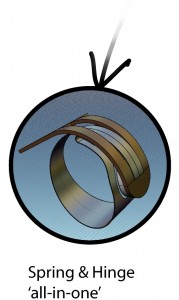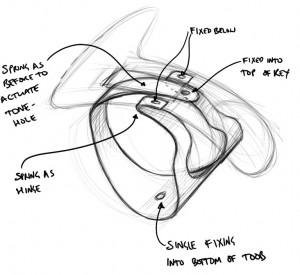It has been a revealing experience so far going back over all this previous work on the toob key design. All these ideas have had the first flush of enthusiasm hammered out of them now and it’s good to look back at them in a new light. This week in particular we’ve been seized by a new passion for the fabric hinge seen in the previous ‘Part 2‘ post. Talking it through again we really feel that there’s more work to be done to explore the potential of this approach to the design.
Today however, I’d like to show you another design idea we’ve been considering;
In previous posts you’ll have seen us exploring a wrap round flat leaf spring to provide the spring force to the key. This concept takes this one step further with the idea of a formed and profiled spring that carries both the spring and hinge functions.
This is similar to the fabric hinge, but the defined hinge point is provided by the formed spring. The advantage of this is that it could be a very simple and elegant assembly, only requiring the key and the spring. The spring can be cut as flat sheet by etching or laser cutting giving potentially more complex forms or engraving.
Looking further into spring production suggests we may need larger production runs to justify them or tooling up the mk workshop with some new kit.
Below is a short video capturing the output of a quick analysis model I did to get a feel for how a key like this would behave in terms of its displacement.
To be a successful key, the spring action of the key needs to be responsive, we have a concern that the shape shown above would actually offer too much resistance because the material at the hinge part and the ‘leaf’ part both contribute. This could probably be engineered out at a later stage though.
Another interesting potential for the design is the idea of linking the springs together into one smooth element, for examples between the Bb and C natural keys which happen to be closely spaced.
This concept has stalled a bit at the moment due to the difficulty of getting spring samples made up, but as ever we’d be interested to hear your views on this.



8 replies on “Design Options – In Depth: Part 3”
I like the design of this one best – simple (few parts), low profile . Concerns would be as you say, accomplishing the proper amount of resistance for comfortable playing, while still closing the tone hole completely. Would this remain consistent in use over time? ie: any issues of spring fatigue, where either the tension changes, or the shape is distorted and “memory” does not return. Consider whether this design is any more prone to damage when the instrument is cased (such that keys are squished), or dropped, or a key is forced beyond the intended opening amount (such as key snagged slipping into a soft case).
Hi Kevin, thanks again for all your comments, invaluable as ever! I think that the issue of robustness as made Misha quite concerned on this one too. I always have to remind myself that these are instruments that have to survive a good pub session too!
Just back from an Easter break so hope to be posting some more work soon…
Hello Brian.
I cannot wait to see the finished design of the Toob! The idea of making music on a well designed chromatic whistle is candy for my imagination. 🙂
Good luck to you-
would the spring not distort with off centre loading?
I know this is three months from the time of posting, but hey, why not…
I’d be interested to know what exactly is this chromatic system aiming for: initial sketches show a mechanism mounted on posts parallel to the length of the whistle with open standing keys as per Boehm instruments, and an early prototype seems to be almost identical to simple-system instruments. The later ones… well, they don’t resemble anything – yet, so I’m assuming they’d be going with the simple-sytem.
I am inclined to think that the age-old simple-system’s block mounted keys would be a more elegant solution; because the body material is metal and not wood, the “blocks”, as it were, would be of much lower profile; the pins and leaf springs would be as usual.
I’ve also noticed that the more recent mechanisms would require the player to simultaneously release a key while covering the adjacent hole with the same finger for certain maneuvers; I would think that this might be a bit clumsy for more technical passages?
Well, it’s been three months, so I’m sure there has been recent progress on this project!
@Keech – I think you’ve misunderstood the layouts being discussed. The design (to me) is indeed similar to a simple-system flute. Assume key of D. Adding chromatic playing (Bb, upper C, G#, short F, Eb) would utilize keys all normally in the “closed” position on a D tube. Not sure that a long F would be as feasible, although there are some note combinations that might play more smoothly. Fingering would thus be the same as for a 5- or 6-key Irish flute. Extending the tube and adding 2 keys (for low C & C# on a key of D instrument) that are normally in the vented, “open” position is likely a different design problem, and may not even be that desirable.
BTW, I don’t see how metal block mounts would require a different profile shape than wooden ones. One could post-mount keys for a certain simplicity and retain all function. However, traditional keys of that sort are expensive to provide, both in material and labor.
My understanding is that what is being sought is a solution that is cost- and time-efficient, and considers such issues as weight, playability and durability. I’m sure it would also be nice to simplify key design so that instead of 6-8 unique key shapes (as on a flute) be manufactured and fitted, one could use only 1 or 2 unique shapes to provide full functionality within a known, common fingering system.
Thanks very much for the comments.
@keech I must admit that at first I did think that exploration of new key systems would invariably lead towards either the Simple or Boehm key systems. It was almost a surprise to myself when upon building a prototype it seemed that this idea did have some mileage – I was pleasantly surprised. It’s not the same as the simple system in that the finger ‘action’ required to actuate keys is quite different – it uses a bend in the finger rather than rolling it with a partial twist of the wrist.
@Kevin absolutely – I think you’ve hit the nail on the head in terms of simplifying the key system. To put it a similar way – how do we maintain the elegant simplicity of a whistle but extend the possibilities by making the chromatic scale easily accessible.
Nothing much has happened in the last few months as Brian and myself have been very busy – myself with A, Eb and G prototyping and Brian designing liferafts, wave-machines and other weird and wonderful things. Both looking forward to getting blank patch to be able to make some more progress….
I really like this idea. I’ve got some osteoarthritis in my fingers and this might really help.